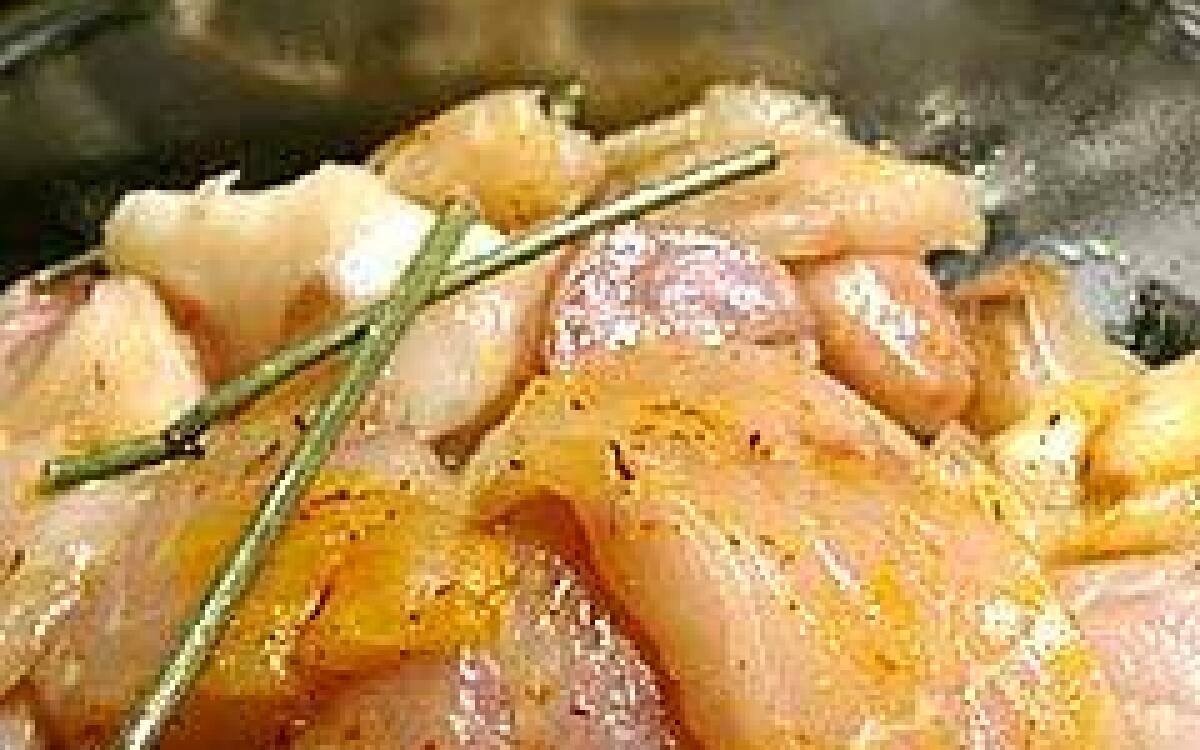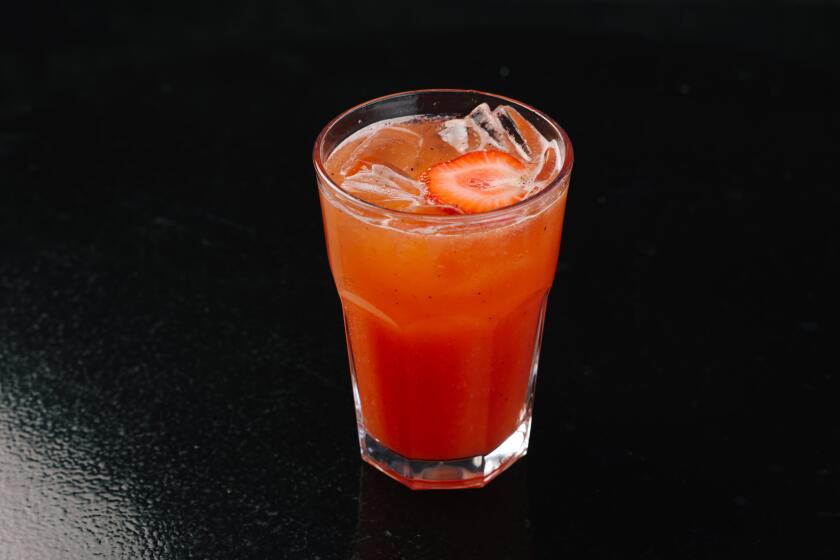Fish stock for California bouillabaisse

Say “bouillabaisse” to a knowledgeable cook and you’re likely to hear, “We can’t make that here. We don’t have the right fish.”
French food purists will tell you you need rascasse, that terrible-looking scorpionfish that lends the broth its velvety body and deep flavor. Or at the very least, chapon -- another ugly scorpionfish -- not to mention galinette, also known as gurnard.
Chapon? Galinette? Not to panic, mes amis. The truth is that outside the Mediterranean, Southern California may be the best place in the world to make bouillabaisse. Not only do we have excellent stand-ins for scorpionfish right here in the Pacific (and waiting to be purchased -- often even live -- at many Asian markets), but we also have wild fennel, which, if you haven’t noticed, is everywhere. Make bouillabaisse in New York or Massachusetts or Florida and you’ll have to run around and look for that bottle of Ricard instead.
Widely accepted as having originated in the Provencal city of Marseille, bouillabaisse is a luscious, soupy seafood stew with a rich fish broth flavored with onions, garlic, tomatoes, parsley, leeks, orange peel, basil, thyme, bay leaf, potatoes and wild fennel. Subtle it’s not: Bouillabaisse is a jazzy ensemble in which all these assertive flavors are heard.
Another thing it’s not: a bowlful of tomato-based broth garnished with chunks of expensive seafood such as lobster, shrimp and scallops. Salmon is heresy. The croutons belong under the surface, not on top, and never, ever should it be topped with grated cheese. This last misstep is fine if you’re talking about soupe de poisson, a generic name for French seafood soup, but cheese and bouillabaisse should not be uttered in the same breath.
Real bouillabaisse is very Marseille -- unpretentious, rough and hearty. Neither fancy nor refined, it came into the world as a simple meal assembled by hungry, resourceful fishermen. The juices extracted from the skin and bones of boiled fish give the broth a thick, distinctive, almost cloudy texture and a fresh, profound, rustic taste of the sea.
And that is where the rascasse comes in. Conventional wisdom says that to get a dish remotely similar to the one you’d find in Marseille, the broth must be made with the tiny Mediterranean scorpionfish whose tough skin and bones are boiled and extracted to create the broth.
With its chubby forward body, big head, protruding eyes, coarse flesh and venomous spines, the rascasse is one ugly, unsalable specimen. No wonder Marseille fishermen made soup out of it instead. Hiding out around the rocky, craggy coastline in depths as low as 1,000 feet (hence the big eyes and tough skin), the rascasse flourishes on a diverse diet of Mediterranean crustaceans. Its skin and bones give a distinctive taste and gelatinous texture to fish soup. There’s nothing quite like it.
In Southern California, though, a Pacific variety of rascasse, California scorpionfish -- also known as sculpin -- lurks in the tide pools, kelp forests and rocky bottoms just offshore. Although the sculpin’s flesh is a bit milder in flavor than that of its French kin, the gelatinous juices extracted from the skin, bones and fat heads enrich the broth just the same and produce a California bouillabaisse that is deliciously true to the spirit of the original.
According to the Charte de la Bouillabaisse Marseillaise, a 1980 charter drawn up and signed by 11 restaurants, bouillabaisse must be prepared with at least four of the following fish to be genuine: rascasse, chapon (also known as rascasse rouge), monkfish, John Dory, galinette (gurnard, one of the mullet family) and fielas (conger eel). No serious restaurant chef or home cook near the coast of Provence would consider making a bouillabaisse without rascasse or chapon.
Although many of us know (or don’t know) bouillabaisse from having ordered it in restaurants, in Marseille it’s not particularly known as a restaurant dish, the Charte de la Bouillabaisse Marseillaise notwithstanding. To the Marseillais, fishermen at heart if not by trade, a bouillabaisse is a festive, convivial, lazy, all-day Sunday experience best enjoyed at home with friends and family who vie for their favorite types and parts of fish as Americans would with a holiday turkey. Their favorite places to make and eat it is in cabanons -- makeshift beach, harbor and hillside cabins that have sprouted over the years like wild fennel along Marseille’s long, rocky coastline.
Wherever it’s served, though, it’s always presented in two courses. First, the soup makes a solo appearance ladled over a slice of dried, garlic-rubbed bread that has been smeared with rouille, a spicy, garlicky mayonnaise. (Although many contemporary cooks prefer to toast or grill the bread, it’s not traditional, and in fact was vigorously opposed by Apollon Caillat, the great Marseille chef whose bouillabaisse recipe was recognized as definitive by Escoffier.) For the second course, potatoes and white-fleshed fish such as monkfish, rockfish (such as red snapper) or John Dory that have been poached in the broth are placed in the bowl with just enough hot soup ladled over to warm them.
In Marseille, it’s all washed down with cassis -- a dry white wine from a coastal region near Marseille -- or a Bandol rose. Preceded by nothing more complicated than olives, croutons, little dishes of tapenade and anchoiade -- and of course glasses of Ricard, which are obligatory in the region -- bouillabaisse is a meal in itself.
Humble origins
The most likely hypothesis on the origin of bouillabaisse is that centuries ago, fishermen returning from sea had two immediate objectives: feed themselves and make use of the unsalable fish and fish scraps caught in their nets. They presumably accomplished both by building a fire on the beach, setting a caldron atop it, and boiling their disfigured or just plain ugly catch, of which scorpionfish is both, in seawater. They then tossed in hunks of stale bread, the precursor to the rouille-dabbed slices, to render the bread chewable and to stretch the meal.
Over time, it evolved into a glorious stew sometimes referred to as soupe d’or for the addition of costly, gold-colored saffron. This gilding of bouillabaisse coincided with the commercial expansion of Marseille in the 19th century. The deluxe hotel-restaurants prepared increasingly refined bouillabaisses for eminent travelers passing through Marseille -- among them Alexandre Dumas, Gustave Flaubert and Emile Zola -- who in turn carried their fond memories of the exotic specialty to Italy, North Africa, the Near East and Paris. From then on, the city and the soup became inseparable.
The great news for California bouillabaisse fans is that sculpins are not hard to find -- or expensive. No, they probably won’t be available at your local supermarket, but whole sculpins can be found fresh -- and often live -- at Ranch 99, Hawaii Supermarkets and other Asian markets. Oceanside Seafood on Redondo Beach Pier also stocks sculpin. Otherwise, few independent local fish markets dare display it. The fear is that if the fish’s appearance and name don’t scare people off, the warnings about its prickly and poisonous spines probably would.
Considering the dearth of low-priced choices, Richard Thackerson of Santa Monica Seafood does see a future for scorpionfish. But it would probably have to be marketed under a more enticing name. “Maybe something French,” he says. (Rascasse? Poisson de bouillabaisse?) And as fillets instead of the whole fish.
Anise-like flavor
In Marseille, the sweet, fragrant stems of wild fennel, which grows in the scrublands of Provence and is gathered by home cooks (it’s never sold in stores), are used to infuse the soup with a delicate anise-like flavor and aroma. Wild fennel grows in few other places, but here it is found not only on wild hillsides, but also along city streets and in vacant lots. (I found some recently on the southern side of Melrose Avenue, just east of Virgil Avenue.)
Bouillabaisse is made in two distinct stages. The term “bouillabaisse” is widely believed to be a conjunction of the words bouillir, “to boil,” and abaisser, “to turn down” or, in its culinary usage, “to reduce,” thereby summarizing the first stage. To prepare the stock, rockfish are added to sweated onions and leeks. While the fish are cooking, you stir them vigorously until they fall apart and almost dissolve into the oil. You then add the rest of the stock ingredients, along with several quarts of water, and boil for nearly 30 minutes. The goal is to extract every last molecule of flavor. The stock is then passed through a food mill or chinois to press out every drop of seasoned fish juice, after which the fish scraps and bones are discarded.
The rich, thick stock is returned to a boil and scented with saffron. The stock is used as a poaching liquid for the potatoes and fish that make up the second course. The fish and potatoes are removed with a slotted spoon and served at room temperature, warmed only by a small amount of hot soup ladled over them.
California may not have cabanons, but its dry air and rocky, sun-kissed coast are suggestive of the conditions that surround the cabins in the South of France. Although Caillat once said that “anyone who has not tasted the authentic bouillabaisse and not joined in a cabanon party knows nothing and has seen nothing,” he’d likely never eaten it in Southern California. Here, Santa Ana winds take the place of the mistral of Provence, carrying the scent of wild fennel from the dry hills and canyons down over the porches, patios and gardens and through the open windows of Los Angeles, where the soup is ladled out to hungry family and friends. It’s a place bouillabaisse can call home.
Heat the olive oil in a large, heavy-bottomed stockpot over medium heat. Add the onions and leeks and sweat, stirring often and making sure the onions and leeks do not color, for 10 minutes. Add the garlic and continue to sweat, stirring often and lowering the heat if necessary, until onions and leeks have “melted” into the olive oil, about 15 minutes.
Add the fish, increase the heat to high and cook, stirring often and vigorously without concern about crushing, mashing or otherwise bruising the fish parts, until the fish falls apart and begins to dissolve into the soup, about 10 minutes.
Add the tomatoes, orange peel, celery, thyme, bay leaves, red pepper flakes and fennel stems or pastis. Lower heat a little to prevent burning, and cook, stirring frequently, for 10 minutes.
Pour the boiling water over all, lower the heat, and cook at a simmer for 25 minutes.
Pour some of the mixture through a food mill or chinois, working with small quantities of fish scraps and vegetables, wetting them down with the bouillon to ease the flow. Be sure to press down on the fish scraps with a pestle or wooden spoon so their juices seep out. Do not give up early. Some of the tastiest and richest juices will be the last to be extracted. Use the hot bouillon judiciously, periodically wetting each batch of fish scraps to help you press out the juices. When you are sure there is no more juice to be had, discard the fish scraps and begin anew with another batch of fish scraps until all the mixture has gone through the mill.
Season to taste with salt and freshly ground pepper. Store in the refrigerator for up to two days or freeze until ready to use.
Get our Cooking newsletter.
Your roundup of inspiring recipes and kitchen tricks.
You may occasionally receive promotional content from the Los Angeles Times.















